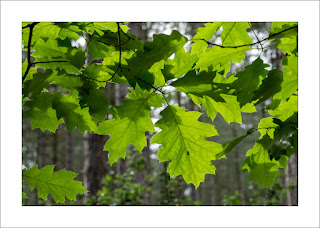I also did some background research and found some references for the different oaks in Sherwood. For example, the Nottinghamshire Local Biodiversity Action Plan (2008) listed the following threat to the native oak-birch woodlands:
The replacement of native broadleaved trees with nonnative conifers and hardwoods such as red oak and beech
Further, the State of Nature in Sherwood Report 2015 listed the Turkey Oak as an invasive non-native plant species in Sherwood.
With this in mind, I returned to the autumn locations (one near to Hanger Hill in Sherwood and the other in Clipstone Forest) to see if I could find a red oak and possibly a Turkey oak.
I started by identifying the native species, the English oak (Quercus robur) and the sessile oak (Quercus petraea). The English oak can be distinguished by the leaves which have almost no stem and grow in bunches:
In contrast sessile oak leaves have longer stalks and the stalks are hairy on the rear of the leaf. Later, when the acorns have grown the English oak acorns will have stalks (or penduncles) and the sessile oaks will be sessile or stalkless:
In comparison with the native species, the leaves of a red oak (Quercus rubra) have more pointed lobes and the leaf vein extends to the edge of the leaf creating a point. These were some that I found in both Sherwood Forest and Clipstone Forest:
Judging by the photographs I am now happy that the above leaves are are red oak leaves. I also photographed the tree bark for reference:
I didn't find a Turkey oak (1) but I did come across some leaves on the path which I traced to a nearby tree. These looked different to the red oak having a waxy or shiny appearance and a different lobe shape. I am not sure what these are, they do look like some reference pictures of red oak leaves but also fit a description of the scarlet oak. I think I will reserve judgement for now and do some more research, perhaps when the acorns appear later in the year.
(1) Whilst writing this I came across the Woodland Trust's description of a Turkey oak. As an interesting fact they say "Turkey oak is host to the gall wasp Andricus quercuscalicis, whose larvae damage acorns of native British oaks. In 1998, the Ministry of Defence ordered the felling of all Turkey Oaks on its UK bases". I suspect that the same applies to Sherwood Forest but as the acorns of the Turkey oak are distinctive I will keep an eye out over the summer.
I started by identifying the native species, the English oak (Quercus robur) and the sessile oak (Quercus petraea). The English oak can be distinguished by the leaves which have almost no stem and grow in bunches:
In contrast sessile oak leaves have longer stalks and the stalks are hairy on the rear of the leaf. Later, when the acorns have grown the English oak acorns will have stalks (or penduncles) and the sessile oaks will be sessile or stalkless:
In comparison with the native species, the leaves of a red oak (Quercus rubra) have more pointed lobes and the leaf vein extends to the edge of the leaf creating a point. These were some that I found in both Sherwood Forest and Clipstone Forest:
Judging by the photographs I am now happy that the above leaves are are red oak leaves. I also photographed the tree bark for reference:
I didn't find a Turkey oak (1) but I did come across some leaves on the path which I traced to a nearby tree. These looked different to the red oak having a waxy or shiny appearance and a different lobe shape. I am not sure what these are, they do look like some reference pictures of red oak leaves but also fit a description of the scarlet oak. I think I will reserve judgement for now and do some more research, perhaps when the acorns appear later in the year.
(1) Whilst writing this I came across the Woodland Trust's description of a Turkey oak. As an interesting fact they say "Turkey oak is host to the gall wasp Andricus quercuscalicis, whose larvae damage acorns of native British oaks. In 1998, the Ministry of Defence ordered the felling of all Turkey Oaks on its UK bases". I suspect that the same applies to Sherwood Forest but as the acorns of the Turkey oak are distinctive I will keep an eye out over the summer.











No comments:
Post a Comment